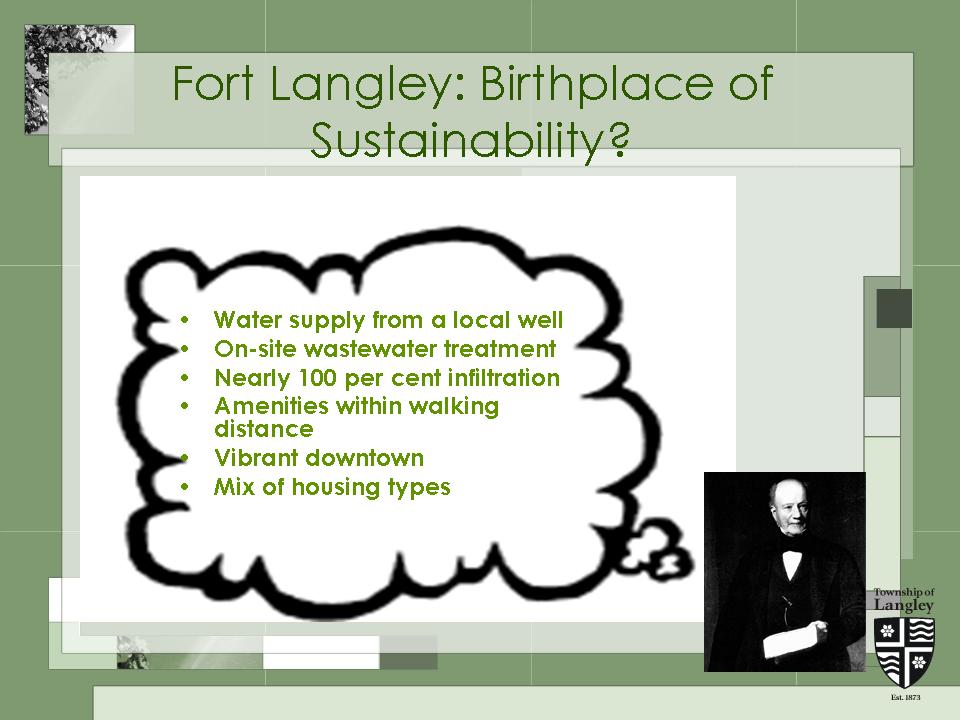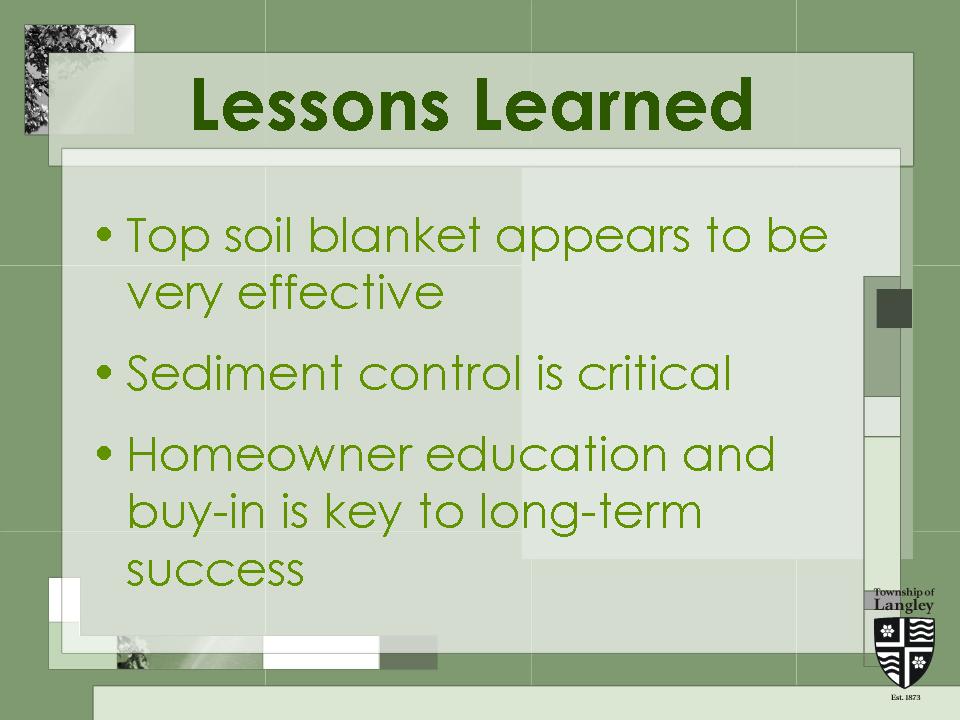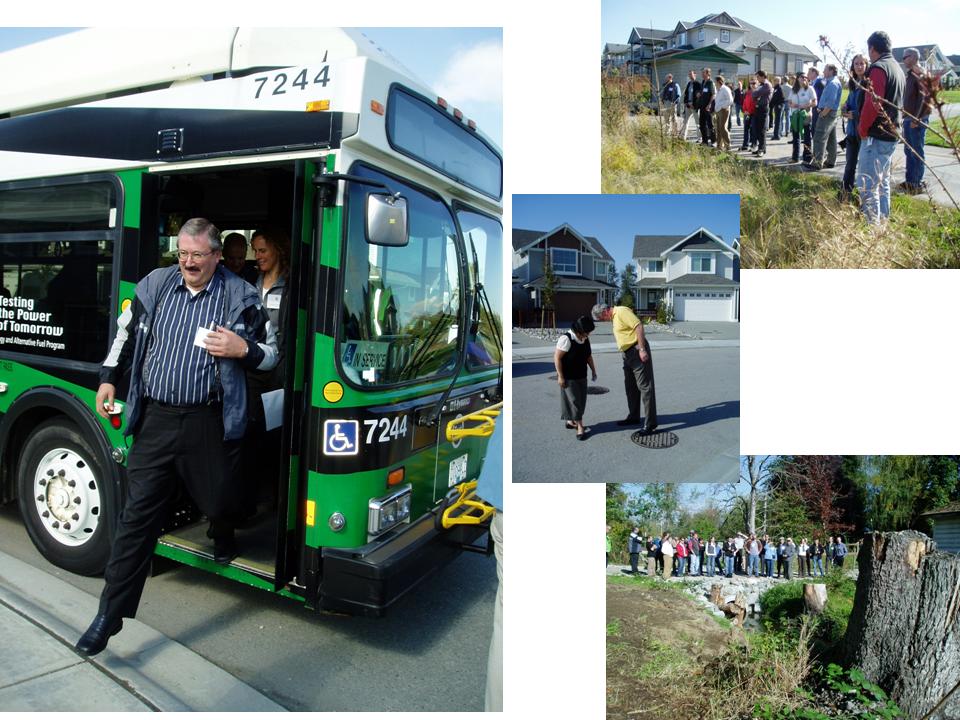Township of Langley Showcases Green Infrastructure Innovation in New Neighbourhoods
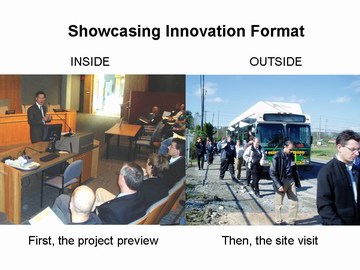
Second of three events focuses on how a ‘water-centric’ approach is changing the way that land is developed
The projected growth of the Metro Vancouver region and resulting cumulative impacts are drivers for reassessing how land is developed and water is used. To promote a new way-of-thinking related to infrastructure policies and practices, the Green Infrastructure Partnership has organized Showcasing Green Infrastructure Innovation in Greater Vancouver: The 2007 Series.
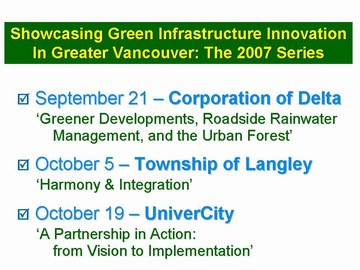
The Showcasing Innovation Series
The Showcasing Innovation Series comprises three one-day events. Each is structured as presentations in the morning and a tour of project sites in the afternoon. The second in the series was hosted by the Township of Langley on October 5.
 To view a previous story, click on Langley Township hosts second in “2007 Showcasing Innovation Series”.
To view a previous story, click on Langley Township hosts second in “2007 Showcasing Innovation Series”.
The goal in showcasing innovation and celebrating successes is to promote networking, build regional capacity, and move ‘from awareness to action’ – through sharing of green infrastructure approaches, tools, experiences and lessons learned as an outcome of designing with nature. To learn more, click on Design With Nature to Enhance the Built Environment.
 “The Showcasing Innovation Series is a regional pilot program that is being implemented by the Green Infrastructure Partnership under the umbrella of the Water Sustainability Action Plan for British Columbia,” reports Kim Stephens, Series organizer and event Moderator, and Program Coordinator for the Action Plan.
“The Showcasing Innovation Series is a regional pilot program that is being implemented by the Green Infrastructure Partnership under the umbrella of the Water Sustainability Action Plan for British Columbia,” reports Kim Stephens, Series organizer and event Moderator, and Program Coordinator for the Action Plan.
Showcasing Innovation in the Township of Langley
The Langley event was titled Harmony and Integration. The Township showcased what can be accomplished with large-scale projects when Council, the community and staff are in alignment and embrace a ‘green culture’. Resource protection – for groundwater supply and fisheries habitat – is the driver for implementing ‘green infrastructure’.
Brad Badelt, Water Resources Engineer and leader of the Langley Showcasing Team, reports that close to 50 people registered for the Langley event.
“When we look at who registered, we are struck by the diversity of the audience. There were representatives from Metro Vancouver, the City of Nanaimo, the Town of Gibsons, eight Metro Vancouver and Fraser Valley municipalities, federal fisheries, a number of private sector organizations, and several non-government organizations,” Kim Stephens elaborated.
“We had a great mix of people and perspectives. We had elected representatives, senior managers, and on-the-ground practitioners,” added Stephens.
Program Scope
Three overview presentations provided context for the day. Councillor Charlie Fox, opened by introducing the Township`s vision for sustainability. Ray Fung, Green Infrastructure Partnership, followed with a synopsis of the Showcasing Innovation Series. Colin Wright and Ramin Seifi closed by elaborating on how the Sustainability Charter is influencing the way the Township does business.
The core program comprised a set of four case study presentations that described current Township initiatives. Please click on the links below to access the PowerPoint slideshow for each case study:
- Case Study 1 – Langley`s GHG Strategy: A Commitment to Reduce Corporate GHG Emissions – The Township recently adopted a Greenhouse Gas Reduction Plan, which plots a corporate course for sustainability. The plan sets an aggressive target for reducing Green House Gas emissions over the next several years. Initiatives include a recently-certified LEED-silver Civic Facility, involvement in the E3 fleet certification program, and an anti-idling campaign.
- Case Study 2 – Protecting Langley`s Groundwater: Safe and sustainable groundwater for our community –The Township relies on groundwater for almost half of its drinking water supply, making it and the City of White Rock unique amongst Metro Vancouver municipalities. This reliance has made groundwater sustainability a top priority: recent initiative include the Water Resource Management Strategy, a Township-wide groundwater model, and a Water Management Planbeing done in partnership with the Province.
- Case Study 3 – Integrated Rainwater Management and Harmony & Integration – The Routley, Yorkson and Northeast Gordon neighbourhood communities illustrate how a ‘water-centric’ approach is changing the way that land is developed in Langley. The plans for these neighbourhoods demonstrate not only integration of surface and groundwater (i.e. to protect water supply), but also integration of engineering and parks to enhance liveability.
- Case Study 4 – Langley Environmental Partners Society: from Awareness to Action – The Langley Environmental Partners Society (LEPS) has a close working relationship with the Township. This partnership has led to many successful outreach and awareness programs such as WaterWise, the Private Well Network, and Water Weeks. These programs are critical for maintaining public support and encouraging public participation in Langley’s sustainability initiatives.
To download a copy of a handout that contains program information for the Showcasing Innovation Series, the Langley agenda, and other pertinent information relating to the Green Infrastructure Partnership and the Water Sustainability Action Plan: click on this link to Langley Showcasing Innovation Handout.
Setting the Context
A Green Infrastructure Partnership theme is that it often takes a third party to bring busy people together. This is the Green Infrastructure Partnership role. According  to Kim Stephens, “Experience shows that intra-region communication among local governments tends to be the exception rather than the rule. The Green Infrastructure Partnership objective is to turn the exception into the rule. ”
to Kim Stephens, “Experience shows that intra-region communication among local governments tends to be the exception rather than the rule. The Green Infrastructure Partnership objective is to turn the exception into the rule. ”
“It was appropriate that the morning session was held in the Township’s Civic Centre, a LEED Silver building,” added Stephens, “This dovetailed nicely with the fact that Langley was one of the first Metro Vancouver municipalities to adopt a Corporate Greenhouse Gas Reduction Plan.”
Langley Council Perspective
According to Councillor Charlie Fox, a recently retired school district administrator and first term member of Council, “The Township of Langley is a community of 100,000 of which  80% of the land area is within the Agricultural Land Reserve. This presents a delicate balance between the preservation of agricultural land and the continued pressure for urban development. It is within this context that the staff and Council champion the theme of harmony and integration as we endeavour to focus on ‘green’ initiatives and programs.”
80% of the land area is within the Agricultural Land Reserve. This presents a delicate balance between the preservation of agricultural land and the continued pressure for urban development. It is within this context that the staff and Council champion the theme of harmony and integration as we endeavour to focus on ‘green’ initiatives and programs.”
“Our Sustainability Charter document which is presently a work in progress will be an important template for all aspects of the Township and how it will do business in the future,” Councillor Fox continued, “Whether it be the day-to-day operations of the Township, the development proposals that come before Council or the important aspects of preserving the lifestyle which so many residents have come to enjoy and expect, the Sustainability Charter document will be an important reference point in the future.”
“Moving ahead on a ‘green’ platform has gained positive momentum in the Township as Council has found it easy to support the initiatives of the staff,” concluded Councillor Fox, “It is easier to move initiatives to the table and through to fruition when you have positive partnerships and working relationships with the residents, stewardship groups, the Township staff and Council as a whole all working in harmony towards the same long term goals.”
Councillor Steve Ferguson also attended on behalf of Langley Council and contributed to the discussion. He reinforced the statement of Council philosophy when called upon by Councillor Fox to elaborate at several points. Councilor Ferguson also contributed his comments and observations at other points in the program.
Green Infrastructure Partnership Perspective
Ray Fung, Manager of Utilities for the District of West Vancouver, spoke on behalf of Paul Ham, Chair of the Green Infrastructure Partnership. In his overview remarks, he provided the next level of detail in highlighting how the Green Infrastructure Partnership is collaborating with local governments to provide a  unique forum for them to tell their stories.
unique forum for them to tell their stories.
According to Ray Fung, “All of us have attended workshops, seminars and conferences where we simply sit and listen all day. And at the end of the day, we go back to our offices and we carry on doing what we were doing.”
“Convening for action…when we are convening in a forum such as today, however, it is not just for the sake of listening,” he continued, “Rather, when we leave here today we want to use what we have learned so that we can take action and make a difference in our professional lives. That difference is to change the way we develop land.” For the complete story on what Ray Fung said, please click here.
To downloiad a copy of his PowerPoint presentation, please click on this link to Convening for Action to Change the Way We Develop Land: Design with Nature
Langley Management Perspective:
Colin Wright, General Manager of Engineering, and Ramin Seifi, Acting General Manager of Planning and Development Services, stood side-by-side in explaining the significance and relevance of the Harmony and Integration theme.
According to Colin Wright:
“The Township of Langley is walking the talk when it comes to putting sustainability into practice,” according to Colin Wright, “As municipalities, we are  the focal point…we have to show leadership on-the-ground if our society is to achieve sustainability.”
the focal point…we have to show leadership on-the-ground if our society is to achieve sustainability.”
“In Langley, we believe there is a sea-change about to happen,” Colin continued, “The community is ready for green infrastructure.”
Colin recounted what he learned, and how he has been inspired, by a presentation by Dr. Douglas McKenzie-Mohr about community-based social marketing at the recent annual conference of the American Public Works Association.
Douglas McKenzie-Mohr, author of the book Fostering Sustainable Behaviour, offers detailed steps to uncover the barriers that inhibit individuals from engaging in sustainable behaviors. He offers tools for practitioners to move people from good intentions to action. He places an emphasis that this work be done at the community level and involve direct contact with people.
For two decades Douglas McKenzie-Mohr, an environmental psychologist, has been incorporating scientific knowledge of behaviour change into the design and delivery of community programs. As the founder of community-based social marketing,he has repeatedly illustrated its utility in his writing,workshops and consulting.
To provide context for the Harmony and Integration theme, Colin paraphrased a quote from John Muir as follows: “When man tugs on one thing in nature, we quickly find it is attached to everything else.”
“When people ask what do I do, my answer is that I build cities,” continued Colin, “To do that, and do it well, we have to be in harmony with nature. When we are in harmony with nature, things will go well. This also applies to our corporate philosophy at Langley Township. We are working together and in harmony.”
According to Ramin Seifi:
“What we are showcasing today is the outcome of years of inter-departmental collaboration,” stated Ramin Seifi, “It was not a random decision to choose Harmony and Integration as the theme for this Showcasing Innovation event. It  captures our core values.”
captures our core values.”
Ramin added that he is a living example of integration because he is an engineer who heads the planning department. He then elaborated on Langley’s Sustainability Charter.
“After many years of what you would call research, we are now in the developmental phase,” stated Ramin, “We adopted the definition of sustainability as meeting the needs of the present day without compromising the future.”
According to Ramin, “Although the Sustainability Charter is high level, it will guide us in terms of providing focus and monitoring progress. Each Charter goal has a supporting set of objectives complete with specific actions.”
To illustrate what this means, Ramin referred to the Environmental Goal and the related objectives for conserving water, reducing energy use, and improving rainwater/stormwater quality. An example of an action is the Township’s Water Management Plan.
“Also, we will be monitoring and measuring what matters,” concluded Ramin, “This will enable residents and Council to maintain their focus over time.”
Context Presentations
The set of four presentations covered the spectrum from master planning to community outreach, with the theme of Harmony and Integration linking each of the presentations. Langley Township has created a working environment which has resulted in a culture of doing that supports champions and encourages innovation.
Case Study 1 – Langley’s Greenhouse Gas Strategy
 In January 2001, the Township joined the FCM (Federation of Canadian Municipalities) Partners for Climate Protection Program. The program consists of five milestones designed to help local governments reduce their GHG (greenhouse gas) emissions. Ryan Schmidt described what the Township has done in order to receive credit for the first three milestones; and how the Township is currently working on four and five.
In January 2001, the Township joined the FCM (Federation of Canadian Municipalities) Partners for Climate Protection Program. The program consists of five milestones designed to help local governments reduce their GHG (greenhouse gas) emissions. Ryan Schmidt described what the Township has done in order to receive credit for the first three milestones; and how the Township is currently working on four and five.
To download of copy of his PowerPoint presentation, please click on this link to Langley`s GHG Strategy: A Commitment to Reduce Corporate GHG Emissions. For an earlier story on this initiative, click on Climate Change Adaptation: Curbing Greenhouse Gas Emissions in the Township of Langley.
Case Study 2 – Protecting Langley’s Groundwater
 The Township is dealing with a host of issues and challenges that impact on the sustainability of its groundwater supply. Antigone Dixon-Warren described what the Township is doing to respond to each of these:
The Township is dealing with a host of issues and challenges that impact on the sustainability of its groundwater supply. Antigone Dixon-Warren described what the Township is doing to respond to each of these:
- Increasing population and intensification of land use
- Growing demand for water resources
- Dropping groundwater levels
- Highly vulnerable aquifers
- Dropping baseflow levels
- Uncertainty of global warming
- Limitations in groundwater legislation
To download of copy of her PowerPoint presentation, please click on this link to Protecting Langley`s Groundwater: Safe and sustainable groundwater for our community .
Case Study 3 – Integrated Rainwater Management
Each neighbourhood features a different green innovation. Brad Badelt described the multi-purpose greenway and shallow infiltration systems on individual residential properties that were first implemented in Routley; the ‘third-pipe system’ for roof drainage that  connects to a sand filtration treatment system and deep-well injection for aquifer recharge in Yorkson; and most recently, truly ‘green streets’ in North East Gordon Estates. Yolanda Leung built on the harmony and integration theme when she described how rainwater management works in parks.
connects to a sand filtration treatment system and deep-well injection for aquifer recharge in Yorkson; and most recently, truly ‘green streets’ in North East Gordon Estates. Yolanda Leung built on the harmony and integration theme when she described how rainwater management works in parks.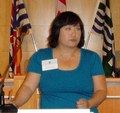
To download of copy of Brad and Yolanda’s PowerPoint presentations, please click on these links to Integrated Rainwater Management and Harmony & Integration, respectively.
Case Study 4 – Langley Environmental Partners Society
The close working relationship between the Township and the Langley Environmental Partners Society (LEPS) has led to many successful programs. Nichole Marples described 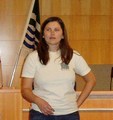 how these educational programs maintain public support and encourage public participation in Langley’s sustainability initiatives
how these educational programs maintain public support and encourage public participation in Langley’s sustainability initiatives
To download of copy of her PowerPoint presentation, please click on this link to Langley Environmental Partners Society: from Awareness to Action .
Scenic Tour
Translink provided one of its experimental hybrid buses for the site tour in the afternoon. The tour featured both the urban and agricultural dimensions of Langley. This provided event participants with a complete experience. Please click on this link to Langley Showcasing Innovation Tour Map to find where these stops of interest are located.
According to Brad Badelt, “We did not want people to leave with the impression that Langley is an intensively developed urban environment. So we included two stops in the agricultural lowlands.”
Erosion & Sediment Control Bylaw
While on the bus, Langley staff told anecdotes about the performance-based Erosion & Sediment Control Bylaw which was developed through an inter-municipal partnership with the City of Surrey and the City of Abbotsford. “In a nutshell, we have a zero tolerance policy to ensure contractor compliance,”  observed Dani Miller.
observed Dani Miller.
The Bylaw applies to all sites where construction activities are occuring which may cause sediment or sediment-laden water to enter the Township drainage system. Turbidity was selected as the unit of measurement because it can be checked instantly with a hand-held meter.
To download a brochure that provides guidance for sites larger than 2000 square metres, click on this link to Erosion & Sediment Control Bylaw – how it applies to developers.
To download a brochure that provides guidance for sites smaller than 2000 square meteres, click on this link to Erosion & Sediment Control Bylaw – how it applies to single family lots.
Routley Neighbourhood
The first two stops were in the Langley Meadows and Routley neighbourhoods.
“We started with the detention pond in Meadows Edge Park at the downstream end, and then we visited the multi-purpose greenway in the upper part of the catchment,” Brad Badelt  reported. “Key features of the drainage system are on-lot infiltration soakaway chambers, top soil depth of 300 mm, and greenway swales with gravel beds,” he explained.
reported. “Key features of the drainage system are on-lot infiltration soakaway chambers, top soil depth of 300 mm, and greenway swales with gravel beds,” he explained.
“Routley was the first step towards achieving a water balance approach,” added Brad Badelt, “In 2005, we implemented a monitoring program to asses drainage system performance. To date, the monitoring has shown that the Routley rainwater runoff volume is on average half that from Langley Meadows, an older development that does not have on-site infiltration. In short, the design is meeting expectations.”
According to Jim Dumont, the engineer of record for each successive innovation in the Routley, Yorkson and Northeast Gordon Estates neighbourhoods, “We were tight for space 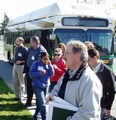 in the Routley area because the rainwater management elements were added after the land use decisions were made. The Meadows Edge pond serves both the original and new upstream neighbourhoods, and is a tight fit. The multi-purpose greenway is located on a gas pipeline right-of-way, and is complete with pathway and stream channel features. It was a major accomplishment to reach an agreement for multi-purpose use.”
in the Routley area because the rainwater management elements were added after the land use decisions were made. The Meadows Edge pond serves both the original and new upstream neighbourhoods, and is a tight fit. The multi-purpose greenway is located on a gas pipeline right-of-way, and is complete with pathway and stream channel features. It was a major accomplishment to reach an agreement for multi-purpose use.”
 “The greenway is part of a comprehensive greenway network that will continue down the hillside in the direction of the Civic Centre,” added Yolanda Leung. This can be seen in the photo below which is a southeasterly view from 196th Street looking down to the lowlands.
“The greenway is part of a comprehensive greenway network that will continue down the hillside in the direction of the Civic Centre,” added Yolanda Leung. This can be seen in the photo below which is a southeasterly view from 196th Street looking down to the lowlands.
Yorkson Neighbourhood
The next stop on the tour was the Yorkson uplands. “The Yorkson Lowlands is 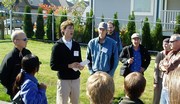 already prone to flooding problems,” explained Brad Badelt, “Because uplands development must not exacerbate the lowlands situation, we needed a strategy for volume management that would be effective.”
already prone to flooding problems,” explained Brad Badelt, “Because uplands development must not exacerbate the lowlands situation, we needed a strategy for volume management that would be effective.”
According to Jim Dumont, “We faced three challenges: first, clayey soils extend to a depth of about 30 metres; secondly, the infiltration rate is less than 1mm per hour; and thirdly, the development form is compact lot which leaves little space to do much on individual properties.”
“Our goal was to maintain the pre-development volume of rainwater runoff,” continued Brad Badelt, “We considered shallow infiltration, but quickly determined that even with a 15 square metre soakaway, we could not meet the volume target.”
 “The solution was a single deep well,” added Jim Dumont, “Runoff from roofs and perimeter drains is collected from each property and conveyed via a third pipe system to a central sand filter. Once the development is fully built out, the well will be activated so that the treated water can be injected into the aquifer.”
“The solution was a single deep well,” added Jim Dumont, “Runoff from roofs and perimeter drains is collected from each property and conveyed via a third pipe system to a central sand filter. Once the development is fully built out, the well will be activated so that the treated water can be injected into the aquifer.”
“One of the keys to the third pipe system is maintaining strict control over the type of roofing material that is used,” noted Brad Badelt.
“A focus of the Yorkson neighbourhood is the greenway feature that is integrated with the storage pond that is part of the rainwater management system,” explained Yolanda Leung, “We have two types of greenways. Those that are located along creeks, and those that are not.”
Northeast Gordon Estates
The tour included a drive-by of the area under development, followed by a stop downstream in the agricultural lowlands where Northeast Gordon Estates outlets.
According to Brad Badelt, “The situation with respect to Northeast Gordon Estates is much the same as Yorkson: poor infiltration; significant fisheries value in some roadside ditches; and downstream erosion issues.”
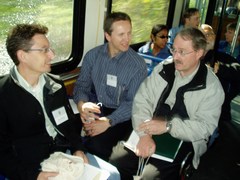 “The plan is to distribute infiltration across the neighbourhood,” explained Jim Dumont, “The top soil depth requirement has been increased to 450mm, thereby providing a soil moisture storage reservoir of 65mm. Also, the streets will actually be green streets because vegetated swales will be underlain by a permeable substrate.”
“The plan is to distribute infiltration across the neighbourhood,” explained Jim Dumont, “The top soil depth requirement has been increased to 450mm, thereby providing a soil moisture storage reservoir of 65mm. Also, the streets will actually be green streets because vegetated swales will be underlain by a permeable substrate.”
North Creek restoration
“For the purposes of demonstrating the uplands-lowlands connection, we decided to include the North Creek restoration project at 64th Avenue,” explained Brad Badelt, “This is a great example of how agricultural drainage can be improved in a way that meets the needs of landowners while actually improving fish habitat.”
“We are quite proud of the precedent that we have established, and what we have accomplished on North Creek,” concluded Brad Badelt, “Because the North Creek project location was not previously fish habitat, we did not require a Section 35 approval from the Department of Fisheries and Oceans. This meant we had more flexibility to create a net benefit.”
Water Sustainability Action Plan for British Columbia
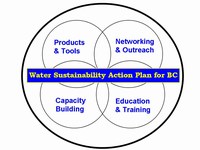 The Water Sustainability Action Plan for British Columbia is sponsored by the Province of British Columbia, and the Action Plan elements are being delivered through partnerships, one of which is the Green Infrastructure Partnership. The Action Plan provides a partnership umbrella for an array of on-the-ground initiatives that promote a ‘water-centric’ approach to community planning and development. .
The Water Sustainability Action Plan for British Columbia is sponsored by the Province of British Columbia, and the Action Plan elements are being delivered through partnerships, one of which is the Green Infrastructure Partnership. The Action Plan provides a partnership umbrella for an array of on-the-ground initiatives that promote a ‘water-centric’ approach to community planning and development. .
The mission of the Green Infrastructure Partnership is to provide leadership and encourage others to implement ‘design with nature’ design practices and regulation province-wide. Implementation by local governments will be voluntary, but once the decision is made to embrace green infrastructure, implementation will need clearly defined standards.
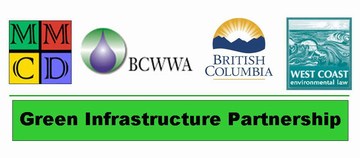
Posted October 2007



